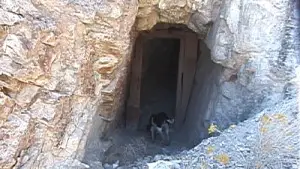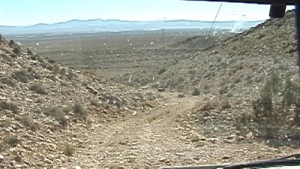SHAUNTIE
|
SHAUNTIE |
|
|
|
| NAME: Shauntie
COUNTY: Beaver Co. ROADS: 4WD GRID: 7 CLIMATE: Snow. In the foothills. BEST TIME TO VISIT: Spring, fall |
COMMENTS:
Shauntie was a mining town west of Milford
flat, based in the foothills. When my Husband gets home I will email more
info as he grew up in Milford flat.Nobody lives there. The town burned down
twice and when the mine was abandoned and people moved, the ranchers and
farmers of the area dismantled anything usable to build in Milford area.
They must not of had a cow in the town as there are hundreds of canned milk
cans, at least that is what they look like and it was fluid because the
cans have 2 large knife holes in the top. We have found other things and
people come dig for bottles. REMAINS: Some footings of shacks over the hill off of the road to the so. Footings of burned buildings on the main street. |
|
I am trying to find out this information myself. I will email an update. Submitted by: Boni Powell Correction: Shawnee, Utah was actually named Shauntie, or in some documents Shaunty, or Shaunty Springs not Shawnee. Update: Early in 1870 prospectors, drifting east from the boom at Pioche, Nevada, and west from the spectacular strike at the Lincoln mine in the Mineral mountains near Minersville, found silver in paying quantities in the Picachio mountains across the valley from Minersville to the west. On July 8, 1870 the Star district was organized. The silver strikes attracted much excitement in both Utah, and Eastern Nevada. By early 1871 the area was so flooded with prospectors, and so many claims were being filed that the district was divided on Nov. 11, 1871 into two districts, the North Star, and the South Star. By 1880 over 1,600 claims had been staked; and the low mountains were swarming with prospectors and mining men. The mines were grouped in five or six different areas, or canyons, each with it�s own mining camp: North Camp or Shenandoah City to the North, Foothills to the East, South Camp to the South, Elephant City or Middle Camp in the middle of the range, and West Camp and Shauntie on the West side of the Mountains. Because it was located at the only regularly running water in the area, Shauntie became the smelting center for the two districts. In 1873 the Shauntie smelter was built with two stacks. In 1874, this smelter was torn down and the larger Shumar Smelter was built, with one stack, but having a 20 ton per day capacity; and employing as many as a hundred workers hauling and smelting the ore being brought in from the Rebel, Elephant, Miner�s Dream, Burning Moscow, and other mines. During the years 1872 to 1877 Shauntie boomed. Soon Shauntie was vying with Shenandoah City as the leading town in the area. Shauntie had over 40 houses of various types, and several businesses including a hotel, several saloons, it�s own post office, and stores. In June of 1875 the smelter burned to the ground, but it was quickly rebuilt and pouring out even more bullion than before. In 1876 Shauntie, itself was destroyed by fire. This still didn�t stop Shauntie. The town was soon rebuilt and was attracting the attention of mining men from all over the west. The veins in the Star districts proved to be shallow however, and by 1877 many of them were closing as their veins pinched out. Just as depression set in and the miners and prospectors of Shauntie were wondering where to go next, News of new discovery excited the ears of the investors and miners. A fabulous new mine, the �Bonanza� had been discovered just 10 miles to the Northwest in the San Francisco Mountains. As fast as the camps of the Star districts were built, so they were abandoned. As news of the discovery reached the others in the district, they just picked up and left, flocking to the new mine which had just been re-named the �Horn Silver� hoping to find work, or profit at the new diggings. Shauntie and the other camps were left abandoned for thirty three years. In 1910 there was a small resurgence when the Burning Moscow, Cedar-Talisman, and Harrington-Hickory mines were re-opened to mine out the low grade ore that was left behind during the boom period. Shauntie again was the center of activity. The Post Office was changed to Moscow in honor of the Burning Moscow mine, then to Talisman, but the locals still just called it Shauntie. By 1920 the low grade ore was mined out, the few people that stayed to carry on small time mining moved to Milford leaving Shauntie and the other Star District camps deserted and crumbling. Over the years the townspeople and farmers around Milford dismantled and hauled off everything they could use from around the mines leaving just a few shacks and head frames at the mines. Foundations and broken glass scattered through the sagebrush and junipers area all that is left of what was once the thriving camp of Shauntie. Submitted by Bob Goodwin [email protected] |
 Shauntie Courtesy James Allgood  Shauntie Courtesy James Allgood |
|
|